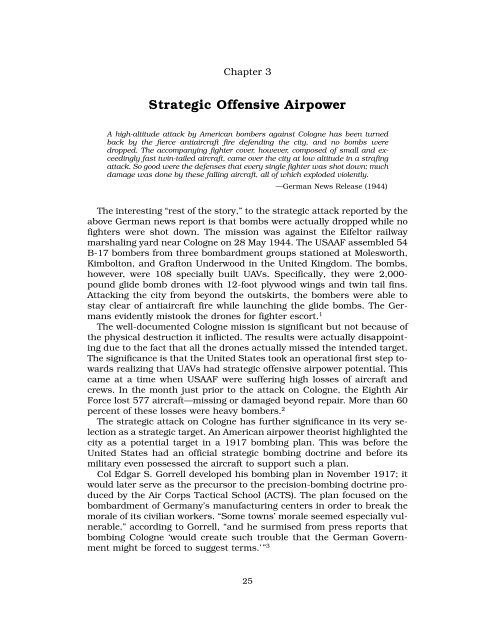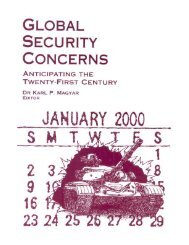54. Kenneth Munson, World Unmanned Aircraft (London: Jane’s Publishing CompanyLtd., 1988), 7. This drone was appropriately named Top Cat.55. Ibid.56. C1C Matthew M. Hurley, “The Bekáa Valley Air Battle, June 1982: Lessons Mislearned?”Airpower Journal, Winter 1989, 60–70. While many sources detail Israeli use ofUAVs during the Middle East conflicts, a unique perspective on their most recent applicationis provided by C1C Hurley.57. Col William E. Krebs, “Did We Err in the Development of <strong>Remotely</strong> <strong>Piloted</strong> <strong>Vehicles</strong>(RPVs)?” Research Report no. MS 018-79 (Maxwell AFB, Ala.: Air War College, 1979), 50.58. Ibid., 15.59. Taylor and Munson, 30–33.60. General Accounting Office (GAO), study, “DOD’s Use of <strong>Remotely</strong> <strong>Piloted</strong> VehicleTechnology Offers Opportunities <strong>for</strong> Saving Lives and Dollars” (Washington, D.C.: GAO, 3April 1981), 8.61. Anne Marie Cunningham, “Unmanned Flying <strong>Vehicles</strong>,” Technology Review, April1991, 16.62. Krebs, 47.63. Krebs, 48. General Sylvester made these arguments at a 1978 RPV symposium.64. Biltz et al., 56–63.65. “The RPV/Drones/Targets Market, 1975–1985.”66. Maj Ronald L. McGonigle, “Unmanned Aerial <strong>Vehicles</strong> (UAVs) on the Future TacticalBattlefield—Are UAVs an Essential Joint Force Multiplier?” (Fort Leavenworth, Kans.:8 December 1992). This argument has been made in various <strong>for</strong>ms. For example, a relatedassertion is that overcoming organizational resistance, not technology, is the major barrierto RPV acceptance.67. Krebs, 27.68. GAO study, 8.69. Ibid., 10.70. This chapter referenced a few past military leaders (e.g., Foch, Towers, and Nimitz)who criticized new technologies.71. Shaker and Wise, 170–72. This is an excellent reference on the classic treatment ofuser reluctance. They present the argument that militaries are “primarily run by skilledoperators who have been promoted up through the ranks,” and “there is a natural reluctanceon the part of the leadership . . . to embrace robotic vehicles that may reduce the influenceof the manned systems and their operators.”72. GAO, “Unmanned <strong>Vehicles</strong>: Assessment of DOD’s Unmanned Aerial Vehicle MasterPlan” (Washington, D.C.: GAO, December 1988).73. Air Force Manual 1-1, Basic Aerospace Doctrine of the United States Air Force, vol.1, March 1992, 17.74. Richard P. Hallion, Storm over Iraq: Air Power and the Gulf War (Washington, D.C.:Smithsonian Institution Press, 1992), 312.75. Longino, 9–13. The author provides a good account of UAV and RF-4 operations inDesert Storm.76. MSgt Merrie Schilter Lowe, “Air Force May Need Fewer Aircraft in the Future,” AirForce News, on-line, Internet, 1 March 1996. General Fogleman made the statement at theannual Air Force Association symposium in Orlando, Florida, on 15 February 1996.77. “UAVs Could Replace Several Manned Aircraft, Owens Says,” Air Force News, online,Internet, 1 March 1996. Admiral Owens’s words were spoken days be<strong>for</strong>e he wasabout to retire after 34 years in service.78. Shaker and Wise, 21.24
Chapter 3<strong>Strategic</strong> <strong>Offensive</strong> AirpowerA high-altitude attack by American bombers against Cologne has been turnedback by the fierce antiaircraft fire defending the city, and no bombs weredropped. The accompanying fighter cover, however, composed of small and exceedinglyfast twin-tailed aircraft, came over the city at low altitude in a strafingattack. So good were the defenses that every single fighter was shot down; muchdamage was done by these falling aircraft, all of which exploded violently.—German News Release (1944)The interesting “rest of the story,” to the strategic attack reported by theabove German news report is that bombs were actually dropped while nofighters were shot down. The mission was against the Eifeltor railwaymarshaling yard near Cologne on 28 May 1944. The USAAF assembled 54B-17 bombers from three bombardment groups stationed at Molesworth,Kimbolton, and Grafton Underwood in the United Kingdom. The bombs,however, were 108 specially built UAVs. Specifically, they were 2,000-pound glide bomb drones with 12-foot plywood wings and twin tail fins.Attacking the city from beyond the outskirts, the bombers were able tostay clear of antiaircraft fire while launching the glide bombs. The Germansevidently mistook the drones <strong>for</strong> fighter escort. 1The well-documented Cologne mission is significant but not because ofthe physical destruction it inflicted. The results were actually disappointingdue to the fact that all the drones actually missed the intended target.The significance is that the United States took an operational first step towardsrealizing that UAVs had strategic offensive airpower potential. Thiscame at a time when USAAF were suffering high losses of aircraft andcrews. In the month just prior to the attack on Cologne, the Eighth AirForce lost 577 aircraft—missing or damaged beyond repair. More than 60percent of these losses were heavy bombers. 2The strategic attack on Cologne has further significance in its very selectionas a strategic target. An American airpower theorist highlighted thecity as a potential target in a 1917 bombing plan. This was be<strong>for</strong>e theUnited States had an official strategic bombing doctrine and be<strong>for</strong>e itsmilitary even possessed the aircraft to support such a plan.Col Edgar S. Gorrell developed his bombing plan in November 1917; itwould later serve as the precursor to the precision-bombing doctrine producedby the Air Corps Tactical School (ACTS). The plan focused on thebombardment of Germany’s manufacturing centers in order to break themorale of its civilian workers. “Some towns’ morale seemed especially vulnerable,”according to Gorrell, “and he surmised from press reports thatbombing Cologne ‘would create such trouble that the German Governmentmight be <strong>for</strong>ced to suggest terms.’ ” 325
- Page 1 and 2: Expendable Remotely PilotedVehicles
- Page 3 and 4: ContentsChapterDISCLAIMER . . . . .
- Page 5 and 6: AbstractThe future holds an acceler
- Page 7 and 8: AcknowledgmentsI thank all the stud
- Page 9 and 10: aircraft. Incorporating the added d
- Page 11 and 12: UAVs were more easily defined when
- Page 13 and 14: Chapter 4 answers the question: Why
- Page 15 and 16: Chapter 2History and BackgroundWe h
- Page 17 and 18: The Wright brothers are deservedly
- Page 19 and 20: aerial bombs), the British took the
- Page 21 and 22: UAVs during World War II to a few g
- Page 23 and 24: On 27 October of that year, another
- Page 25 and 26: United States to look beyond reconn
- Page 27 and 28: ary 1996, Gen Ronald R. Fogleman, A
- Page 29: 29. Shaker and Wise, 28.30. Michael
- Page 33 and 34: ombs, as well as a high sortie rate
- Page 35 and 36: It thus follows that future air cam
- Page 37 and 38: possible for small formations to ac
- Page 39 and 40: spite the successes, it is easily p
- Page 41 and 42: The transmissions used by a control
- Page 43 and 44: 33. Air Force Scientific Advisory B
- Page 45 and 46: diverted 75 percent of its B-29s aw
- Page 47 and 48: Table 6Remotely Piloted Vehicle Adv
- Page 49 and 50: million dollars each. The unit flya
- Page 51 and 52: Relative Ranks for Fewer Design Con
- Page 53 and 54: mission) the open bomb bay doors si
- Page 55 and 56: Relative Ranks for Flight Noise Are
- Page 57 and 58: Owens also stated that the military
- Page 59 and 60: All forms of manned and unmanned ai
- Page 61 and 62: Relative Ranks for Reliability Area
- Page 63 and 64: KEY: ● Major Advantage Counterba
- Page 65 and 66: 7. “Report: Military Crashes Down
- Page 67 and 68: 62. McGonigle, 34.63. Ibid., 33.64.
- Page 69 and 70: expendable RPVs, American political
- Page 71 and 72: cybornaut activates engine thruster
- Page 73 and 74: Chapter 6ConclusionConstant evaluat
- Page 75: one role. A countless combination o






